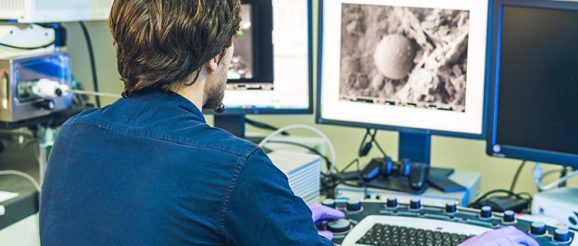The bigger picture: innovation in microscopy – Drug Target Review

Due to the innovative nature of these technologies, O’Toole explained that they are currently in their infancy, creating challenges for data analysis.
“You can do simple data analysis and get yes/no answers, but there is so much more information that we want to know. Does a cell respond to a drug? Which cells are drug resistant? What are their phenotypic differences?” O’Toole said. “QPI allows us to identify new phenotypic traits of cells that are resistant to drugs or behave differently in co-cultures.”
He emphasised that with QPI, co-cultures can be studied without staining, which would impact the growth of a cell in a labelled technique. The lack of a fluorochrome also decreases the phototoxicity of imaging significantly, resulting in less damage to the cells. This also means that cells can be continuously imaged for up to five days, providing a good deal of insight into the effects of drugs on cells. O’Toole highlighted that with ptychography, machine learning can be applied to identify cell subpopulations and then reveal phenotypic differences, to uncover why certain cells are resistant to drugs. This can then indicate how to treat cells and make them susceptible to drugs.
“The other technique, digital holography, is also very interesting because that does not look at a massive field of view. Now we can look at one or two cells, but rapidly and in three-dimensions (3D). You can also look at the membrane internalisation,” O’Toole said. For example, the internalisation of a bacteria can be observed in real time, with the membrane enveloping the particles outside of the cell. “If you were to add particles in there, because the particles have different refractive index, you would be able to see how they are trafficked into the cell and how they are trafficked within the cell.”
O’Toole mentioned that the researchers at York are also investigating the advantages of structured illumination microscopy 2 (SIM2), an improved microscopy method that nearly doubles the resolution, speed and sensitivity of imaging. He commented that this has opened up the capability to watch inter-cellular trafficking of vesicles inside cells that before was very difficult in 3D.
Enter transcriptomics
O’Toole commented that these technologies do not enable the imaging of proteins. However, new fluorescent methods are enabling the analysis of spatial transcriptomics, or the high‑plex phenotyping for protein expressions with spatial resolution on tissues. He explained that fluorescence imaging makes it possible to see how the immune system reacts around diseased or infected areas by looking at, for example, 80 different antibodies simultaneously or 15,000 different RNA transcripts with spatial resolution.
“We no longer have to treat the whole tissue as one, we can now identify areas of infection, look at how it is reacting away from those areas of infection, or away from the areas of tumours,” said O’Toole. “We are trying to then couple that up with other technology platforms, not just microscopy – so we can see how transcriptomics, metabolomics, lipidomics are all now coming together on the one microscope image.”
Bottlenecks for microscopy
Aside from the inability to image proteins, O’Toole highlighted that data analysis is the biggest bottleneck for microscopy. While label-free techniques are non-invasive, have a lower toxicity and enable prolonged time-lapse imaging – which is useful for drug design and drug screens – he said that deeper understanding of the data, rather than the answers to simple questions, can provide scientists with far more information. To combat this bottleneck, O’Toole noted that manufacturers are trying to include more onboard analysis solutions for their imaging products.
He also emphasised the importance of engaging with imaging data via computational methods. While this can provide answers to simple datasets, however, segmentation errors can influence the analysis and outputs. Therefore, machine learning can help to reduce tracking and segmentation errors.
Exciting trends in the field
“In the future, the next five or 10 years’ time, we will be able to take much bigger fields of view to statistically get better data sets,” said O’Toole, “especially when it comes to drug design and the effects of drugs.”
He highlighted that outliers from drug development research will be taken into consideration much more, as they are often most interesting: “If all the cells perform normally and they all react to the drug, this means the drug will be a 100 percent effective. However, this is never the case and it is the outliers that tend to resist a drug. It will therefore be the outliers that would have a negative impact on a patient, yet we often disregard them. Instead, embracing the outliers to investigate how a drug does not work could help us to make them more effective.”
Another direction in which O’Toole predicts future progress is through coupling live cell imaging with single-cell transcriptomics and metabolomics. Alongside this, increased speed, increased sensitivity and interconnected platforms will be the future of imaging. O’Toole said that better integration across different platforms would enable an improved breadth of imaging data.
The importance of academic centres
O’Toole also said that academic centres are where new technologies are initially embraced and optimised from the innovator’s perspective, whether that be a company or a physics or engineering group that are developing the technology.
“It is critical to have an interface where developers can work very closely with end users,” he explained. “That can be a very difficult relationship to manage between the two, because the expectations are always high and when you are at the very cutting edge of innovation, success rates can be very low. On the other hand, the rewards can be very high.”
O’Toole concluded that companies working with academic centres like the one at York enter into a mutually beneficial relationship; by collaborating closely with academics in the early stages of instrument development, they can speed up the development of their system.
 Dr Peter O’Toole is Director of the Bioscience Technology Facility at the University of York. He has built up and heads the Imaging and Cytometry Labs which include an array of confocal microscopes, flow cytometers, electron microscopes and novel instrumentation. O’Toole gained his PhD in the Cell Biophysics Laboratory at Essex and has been involved in many aspects of fluorescence imaging, with his research currently focused on both technology and method development of novel probes and imaging modalities including label‑free, super-resolution and multiplex imaging. O’Toole serves on an array of committees including the Royal Microscopical Society (RMS), European Light Microscopy Initiative, Core Technologies for Life Science and sits on numerous funding panels.
Dr Peter O’Toole is Director of the Bioscience Technology Facility at the University of York. He has built up and heads the Imaging and Cytometry Labs which include an array of confocal microscopes, flow cytometers, electron microscopes and novel instrumentation. O’Toole gained his PhD in the Cell Biophysics Laboratory at Essex and has been involved in many aspects of fluorescence imaging, with his research currently focused on both technology and method development of novel probes and imaging modalities including label‑free, super-resolution and multiplex imaging. O’Toole serves on an array of committees including the Royal Microscopical Society (RMS), European Light Microscopy Initiative, Core Technologies for Life Science and sits on numerous funding panels.
